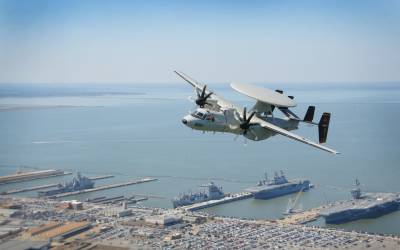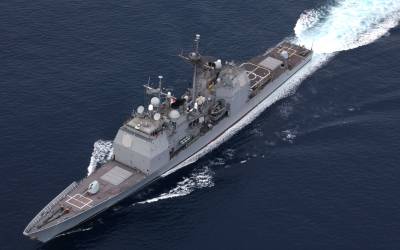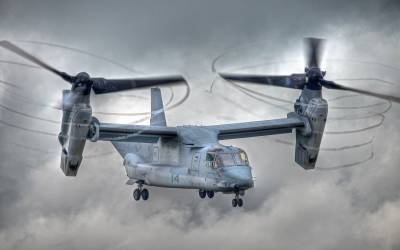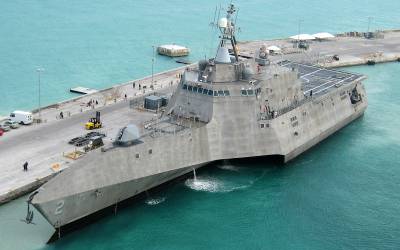April 26, 2024
E-2D Hawkeye: The Navy's New AWACS
(click to view full) Northrop Grumman’s E-2C Hawkeye is a carrier-capable “mini-AWACS” aircraft, designed to give long-range warning of incoming aerial threats. Secondary roles include strike command and control, land and maritime surveillance, search and rescue, communications relay, and even civil air traffic control during emergencies. E-2C Hawkeyes began replacing previous Hawkeye versions in 1973. […]
Full Article Status: paid
April 25, 2024
Serious Dollars for AEGIS Ballistic Missile Defense (BMD)
AEGIS-BMD: CG-70 launches SM-3 (click to view full) The AEGIS Ballistic Missile Defense System seamlessly integrates the SPY-1 radar, the MK 41 Vertical Launching System for missiles, the SM-3 Standard missile, and the ship’s command and control system, in order to give ships the ability to defend against enemy ballistic missiles. Like its less-capable AEGIS […]
Full Article Status: paid
April 22, 2024
V-22 Osprey: The Multi-Year Buys, 2008-2021
(click to view full) In March 2008, the Bell Boeing Joint Project Office in Amarillo, TX received a $10.4 billion modification that converted the previous N00019-07-C-0001 advance acquisition contract to a fixed-price-incentive-fee, multi-year contract. The new contract rose to $10.92 billion, and was used to buy 143 MV-22 (for USMC) and 31 CV-22 (Air Force […]
Full Article Status: paid
April 11, 2024
F-35 Lightning: The Joint Strike Fighter Program
F-35B: off probation (click to view full) The $382 billion F-35 Joint Strike fighter program may well be the largest single global defense program in history. This major multinational program is intended to produce an “affordably stealthy” multi-role fighter that will have 3 variants: the F-35A conventional version for the US Air Force et. al.; […]
Full Article Status: free
April 4, 2024
US Hellfire Missile Orders, FY 2011-2024
USN MH-60S test (click to view full) Hellfire I/II missiles are the USA’s preferred aerial anti-armor missile, and are widely deployed with America’s allies. They equip America’s helicopter fleets (AH-64, AH-1, OH-58D, MH-60S/R), AH-64 and S-70 helicopters flown by its allies, and even Australia and France’s Eurocopter Tiger attack helicopters. Range is officially listed as […]
Full Article Status: free
March 29, 2024
Tomahawk's Chops: xGM-109 Block IV Cruise Missiles
Block IV Cutaway (click to view full) Block IV Tomahawk is the current generation of the Tomahawk family of cruise missiles. The BGM-109 Tomahawk family began life in the 1980s as sub-sonic, low-flying nuclear strike weapons, before being developed into long-range RGM/UGM-109 conventional attack missiles. They’re most frequently launched from submarines and surface ships, and […]
Full Article Status: free
March 21, 2024
Pilum High: The Javelin Anti-Armor Missile
Javelin, firing (click to view full) The FGM-148 Javelin missile system aimed to solve 2 key problems experienced by American forces. One was a series of disastrous experiences in Vietnam, trying to use 66mm M72 LAW rockets against old Soviet tanks. A number of replacement options like the Mk 153 SMAW and the AT4/M136 spun […]
Full Article Status: paid
March 5, 2024
Trident II D5 Missile: Keeping Up with Changing Times
Trident II D5 Test Launch (click to view full) Nuclear tipped missiles were first deployed on board US submarines at the height of the Cold War in the 1960s, to deter a Soviet first strike. The deterrence theorists argued that, unlike their land-based cousins, submarine-based nuclear weapons couldn’t be taken out by a surprise first […]
Full Article Status: paid
March 4, 2024
LCS: The USA's Littoral Combat Ships
Austal Team Trimaran LCS Design (click to enlarge) Exploit simplicity, numbers, the pace of technology development in electronics and robotics, and fast reconfiguration. That was the US Navy’s idea for the low-end backbone of its future surface combatant fleet. Inspired by successful experiments like Denmark’s Standard Flex ships, the US Navy’s $35+ billion “Littoral Combat […]
Full Article Status: sample
February 29, 2024
AMRAAM: Deploying & Developing America's Medium-Range Air-Air Missile
AIM-120C from F-22A (click for test missile zoom) Raytheon’s AIM-120 Advanced, Medium-Range Air to Air Missile (AMRAAM) has become the world market leader for medium range air-to-air missiles, and is also beginning to make inroads within land-based defense systems. It was designed with the lessons of Vietnam in mind, and of local air combat exercises […]
Full Article Status: paid
February 16, 2024
Tomahawk's Chops: xGM-109 Block IV Cruise Missiles
Block IV Cutaway (click to view full) Block IV Tomahawk is the current generation of the Tomahawk family of cruise missiles. The BGM-109 Tomahawk family began life in the 1980s as sub-sonic, low-flying nuclear strike weapons, before being developed into long-range RGM/UGM-109 conventional attack missiles. They’re most frequently launched from submarines and surface ships, and […]
Full Article Status: free
February 12, 2024
Ships Ahoy! The Harpoon Missile Family
Harpoon in flight (click to view full) The sub-sonic, wave-skimming GM-84 Harpoon is the US Navy’s sole anti-shipping missile, with the minor exception of small helicopter-borne AGM-119B Penguin missiles. The Harpoon has been adapted into several variants, and exported to many navies around the world. At present, the Harpoon family includes AGM-84 air, RGM-84 sea/land, […]
Full Article Status: paid
February 8, 2024
AGM-158 JASSM: Lockheed's Family of Stealthy Cruise Missiles
JASSM-ER from B-1B (click to view full) The 2,000 pound AGM-158 JASSM (Joint Air-to-Surface Standoff Missile) is intended to be a stealthy, inexpensive GPS/IIR (Global Positioning system/ Imaging InfraRed) guided cruise missile. It’s designed to attack well-defended targets without putting its carrier aircraft in the crosshairs of new long-range surface to air missile systems. JASSM […]
Full Article Status: sample
January 31, 2024
RAM (Rolling Airframe Missile) Systems: Contracts & Events
Mk-44 firing RAM (click to view full) The Rolling Airframe Missile (RAM) MK-31 guided missile weapon system is co-developed and co-produced under a NATO cooperative program between the United States and German governments to provide a small, all-weather, low-cost self-defense system against aircraft and cruise missiles. The RIM-116 was later called RAM (Rolling Airframe Missile), […]
Full Article Status: paid
January 8, 2024
RIM-162 ESSM Missile: Naval Anti-Air in a Quad Pack
RIM-162: sections (click to view full) The RIM-162 Evolved Sea Sparrow Missile (ESSM) is used to protect ships from attacking missiles and aircraft, and is designed to counter supersonic maneuvering anti-ship missiles. Compared to the RIM-7 Sea Sparrow, ESSM is effectively a new missile with a larger, more powerful rocket motor for increased range, a […]
Full Article Status: paid
January 4, 2024
Timely Defenders: Keeping Patriots in Shape
DID's FOCUS Article covering the Patriot anti-air missile system, including all development & contracts during the FY 2007 time frame...
Full Article Status: paid
November 15, 2023
F-35 Lightning: The Joint Strike Fighter Program
F-35B: off probation (click to view full) The $382 billion F-35 Joint Strike fighter program may well be the largest single global defense program in history. This major multinational program is intended to produce an “affordably stealthy” multi-role fighter that will have 3 variants: the F-35A conventional version for the US Air Force et. […]
Full Article Status: free
November 17, 2023
Trident II D5 Missile: Keeping Up with Changing Times
Trident II D5 Test Launch (click to view full) Nuclear tipped missiles were first deployed on board US submarines at the height of the Cold War in the 1960s, to deter a Soviet first strike. The deterrence theorists argued that, unlike their land-based cousins, submarine-based nuclear weapons couldn’t be taken out by a surprise first […]
Full Article Status: paid
November 20, 2023
V-22 Osprey: The Multi-Year Buys
(click to view full) In March 2008, the Bell Boeing Joint Project Office in Amarillo, TX received a $10.4 billion modification that converted the previous N00019-07-C-0001 advance acquisition contract to a fixed-price-incentive-fee, multi-year contract. The new contract rose to $10.92 billion, and was used to buy 143 MV-22 (for USMC) and 31 CV-22 (Air Force […]
Full Article Status: paid
November 6, 2023
E-2D Hawkeye: The Navy's New AWACS
(click to view full) Northrop Grumman’s E-2C Hawkeye is a carrier-capable “mini-AWACS” aircraft, designed to give long-range warning of incoming aerial threats. Secondary roles include strike command and control, land and maritime surveillance, search and rescue, communications relay, and even civil air traffic control during emergencies. E-2C Hawkeyes began replacing previous Hawkeye versions in 1973. […]
Full Article Status: paid



















